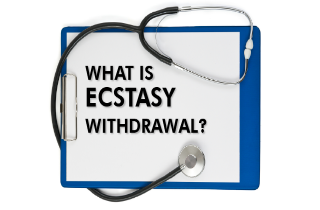More than half of those who use ecstasy report withdrawal symptoms after the high. Why? Because ecstasy targets many of the brain’s neurotransmitters, flooding them with serotonin and then leaving a deficit. In fact, ecstasy stays in your system for about 4-6 hours, after which you crash. Feelings of anxiety and paranoia, problems with concentration and memory, irritability, fatigue, aches and pains and sleep problems are common ecstasy withdrawal symptoms.
Here, we discuss why ecstasy withdrawal symptoms occur and what you can do about it. Then, we invite any questions / comments you may have about ecstasy withdrawal or ecstasy addictive properties at the end. We try to respond to all legitimate queries with a personal and prompt response.
What is ecstasy withdrawal syndrome?
Ecstasy, or MDMA (3, 4-methylenedioxy-methamphetamine), has long been a drug of choice on the party scene because of the feelings of euphoria, lowered inhibitions, increased energy and emotional warmth that it produces. Commonly used in conjunction with other drugs, ecstasy affects the brain and can be habit forming. Long term use of ecstasy is known to cause negative impacts on brain cells; particularly among women.
Though ecstasy is less addictive than some other recreational drugs it does meet addiction criteria such as diminished response (tolerance), dependence, withdrawal effects and craving for the drug. What happens chemically in the body when you take ecstasy? Ecstasy triggers activity within the brain’s neurotransmitters and releases excessive amounts of serotonin in the body. The serotonin surge from ecstasy depletes the brain of this chemical and is the main reason for the withdrawal symptoms such as anxiety, depression, drug craving and sleep disturbances.
What is withdrawal from ecstasy like?
The crash after the high can bring on feelings of anxiety and depression, paranoia, and irritability. Users may experience confusion and find it difficult to focus or concentrate. Depleted serotonin levels make a person feel a lack of motivation and drive. Users may also feel fatigue, dizziness of lightheadedness, digestive disturbances like diarrhea or constipation, physical aches and pains, loss of appetite and sleep problems such as insomnia and bruxism (teeth grinding while asleep).
What does ecstasy withdrawal feel like?
A cross national study has reported that ecstasy withdrawal feels much like dysphoria, or the opposite of being high. Common symptoms that people report include feeling tired, weak, inability to concentrate, irritability, anxiety and restlessness. Twitching, unpleasant dreams and seeing/hearing things that weren’t there were some of the other symptoms. Mixing ecstasy and alcohol, or ecstasy with other psychoactive drugs can exacerbate symptoms.
What helps ecstasy withdrawal?
The only thing that can help ecstasy withdrawal is time. There are few or no medications recommended particularly for long term recovery from ecstasy. However, a combination of planned detox and self help can help users kick the habit.
Detox and tapering – Heavy users of ecstasy may require medically aided detox or tapering programs to help wean off from their drug. Detox from ecstasy may be complicated by the use of multiple drugs to enhance or lengthen the duration of its effects. An addiction expert can guide a user through the difficult withdrawal symptoms by reducing the amounts of drug or drug combinations in a safe and gradual manner.
Symptomatic management – There could be musculoskeletal pain during the withdraw phase, usually due to excessive activity or dancing while high. For this, heating pads or OTC pain relievers such as Ibuprofen and Tylenol can be used. A warm bath can also help with relaxation. Diarrhea, constipation, nausea and other gastrointestinal could occur during withdrawal. Loperamide (Imodium) and eating easy to digest food can help. Dehydration is a common side effect with ecstasy use because of excessive sweating and possible use of diuretic substances (such as alcohol) along with it. So it is important of drink plenty of fluids to keep hydrated.
Control cravings – If you feel a craving for the drug, understand that this is an inevitable part of drug use but that it is important to stay strong. Cognitive behavioral interventions aimed at educating a user, bringing about behavior change and helping them handle life stresses are the principal aims of ecstasy abuse treatment. Speak to a sober friend, develop healthy coping mechanisms and avoid people and places that trigger drug use. Joining a support group is also very useful to help control cravings and overcome ecstasy withdrawal symptoms
Questions about ecstasy withdrawal
Do you have a loved one who uses ecstasy or do you suspect that a loved one may be using ecstasy? Write in to us if you need to know more about how to wean them away from their drug. We will personally answer any questions you may have about ecstasy. User the comment form below for your questions and comments.









Related Posts